A question arose recently about the use of a couche for proofing bread. Here is a demonstration of how to use a linen couche.
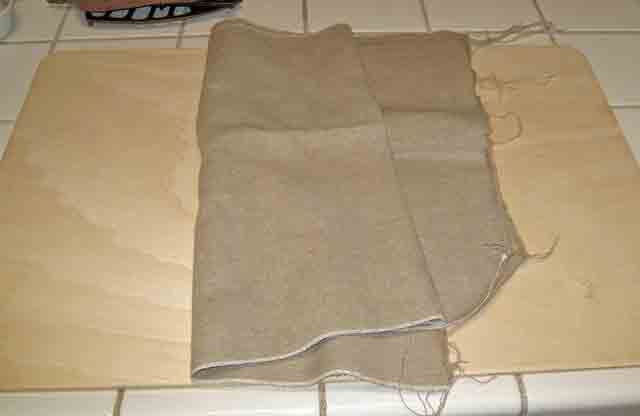
Step 1: Mis en place
Equipment needed: Proofing board and a length of baker's line.
In the bakery, loaves that are not proofed in baskets are proofed on wooden boards covered with baker's linen. After the loaves are placed on the linen between folds, they are covered with heavy plastic sheeting. The boards are then shelved in rolling racks which are usually themselves covered with plastic.
Baker's linen is an ideal material on which to proof loaves. It is relatively inexpensive. It is flexible. It is inherently non-stick. Even when proofing loaves made with high-hydration, somewhat sticky dough, flouring of the linen is generally not needed. The linen absorbs some moisture from the surface of the loaves which makes them easier to score cleanly.
Baker's linen can be purchased from King Arthur Flour or from TMB Baking (affiliated with the San Francisco Baking Institute). The latter's prices are lower. (I have no financial association with either.)
At home, we are usually only proofing 2 to 4 loaves at once, so a simpler procedure can be followed.
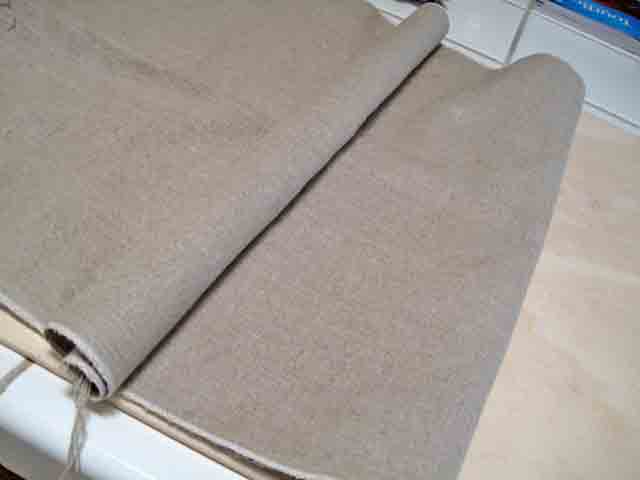
Step 2: Preparing the couche.
Cover the board with the linen. Fold back one end, and roll it up to form a supporting structure for the first loaf place on one end of the couche.
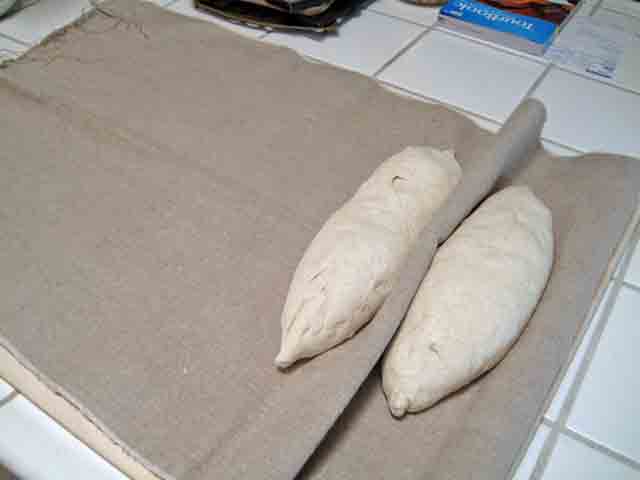
Step 3: Placing the loaves on the couche.
The loaves are placed on the couche. Note the roll of linen supporting the right hand side of the loaf on the right and the fold of linen between the two loaves.
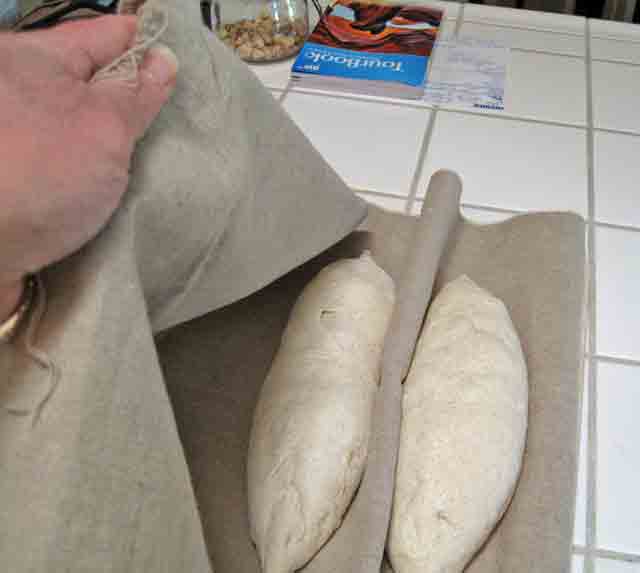
Step 4: The left hand end of the couche is brought up and over to cover the proofing loaves.
Any excess linen can be folded back over to cover the loaves with another layer of linen.
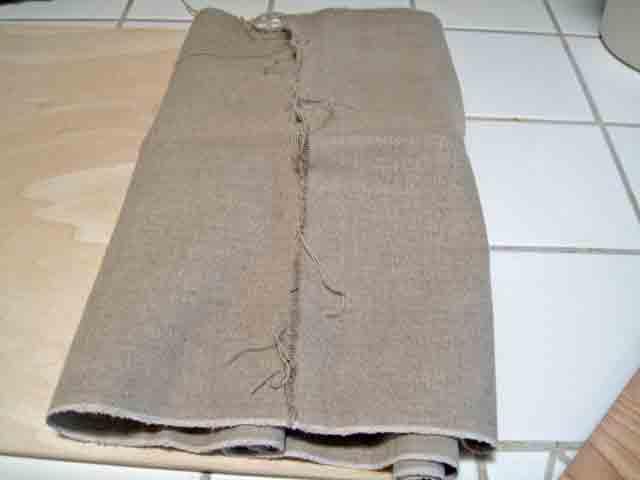
Step 5: The covered loaves are left to proof until ready to bake.
I generally prefer proofing loaves seam side up. The exception is loaves topped with seeds. When transferring loaves proofed seam up with a transfer peel, the loaves must be flipped over on the couche before being transferred to the transfer peel, then to a peel for loading onto a baking stone.
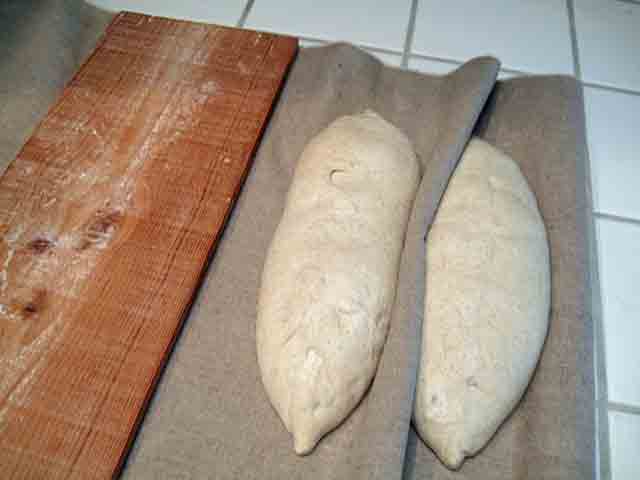
Step 6: Uncover loaves. (Seen with transfer peel)
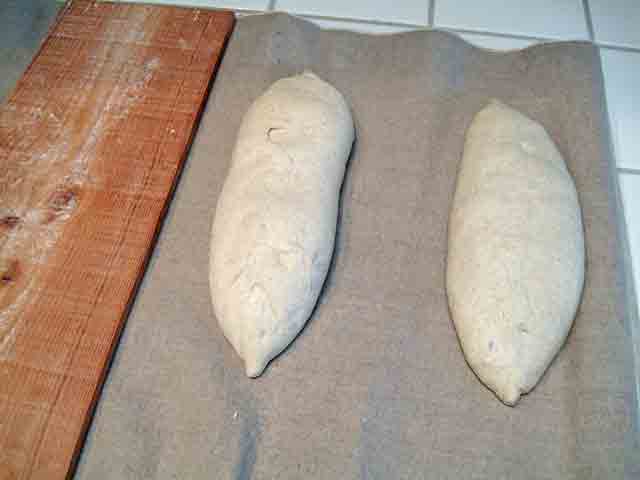
Step 7: Pull linen from left end to flatten out the folds
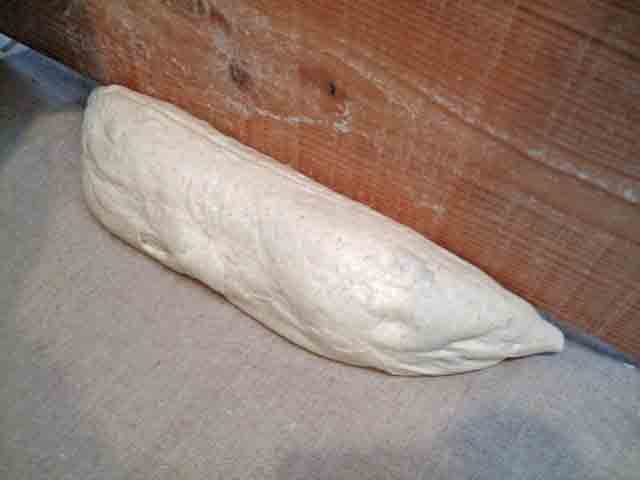
Step 8: If loaves were proofed seam side up, flip them over so the seam is down.
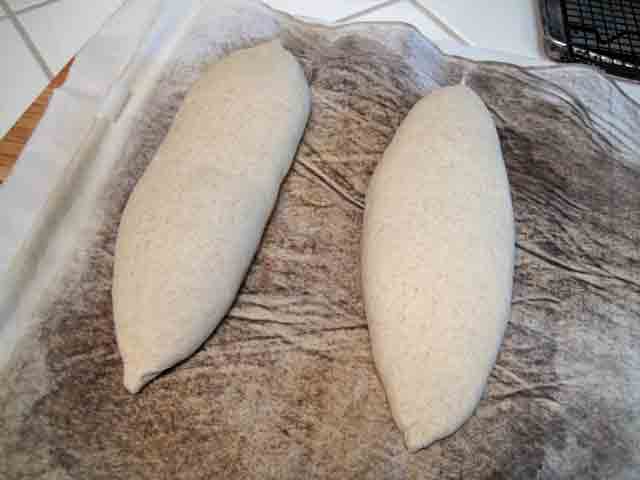
Step 9: Transfer loaves to a peel.
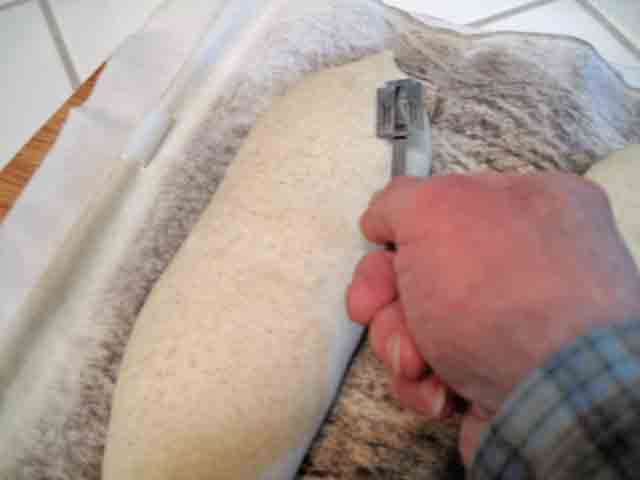
Step 8: Score the loaves.
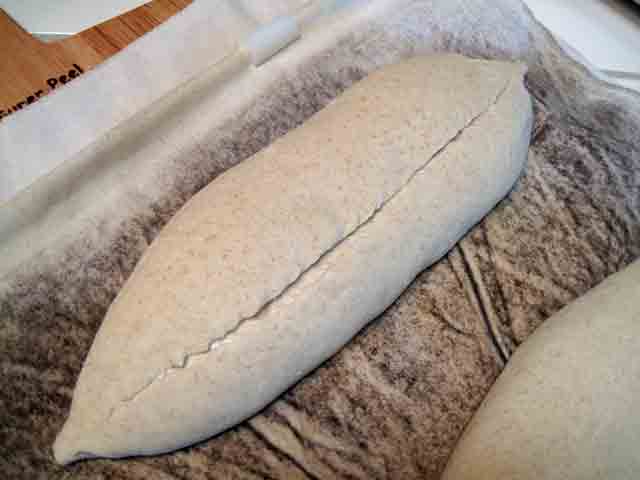
Scored loaves, ready to load.
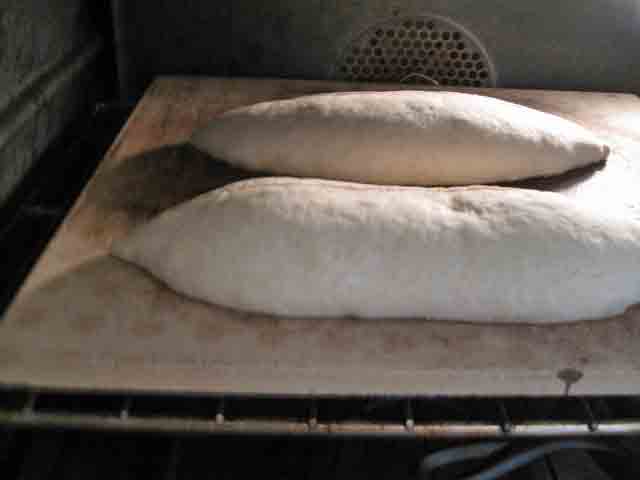
Loaded onto the baking stone.
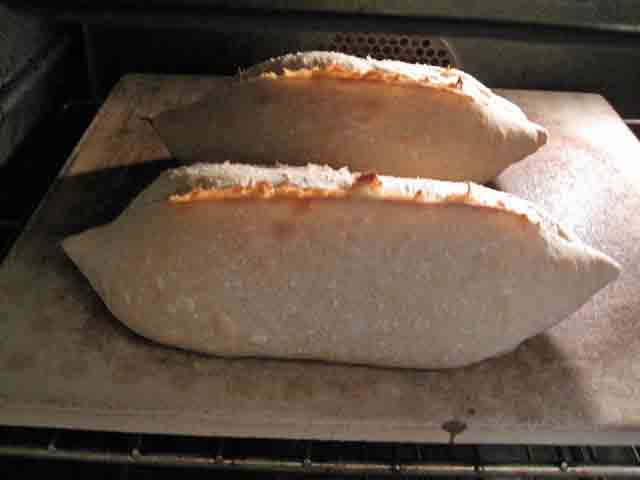
Twelve minutes into the bake. Good oven spring. The cuts have opened nicely with good ears. The loaves have just started to color. Time to vent the steam.
After another 13 minutes baking and 7 minutes resting in the turned off oven with the door ajar ...
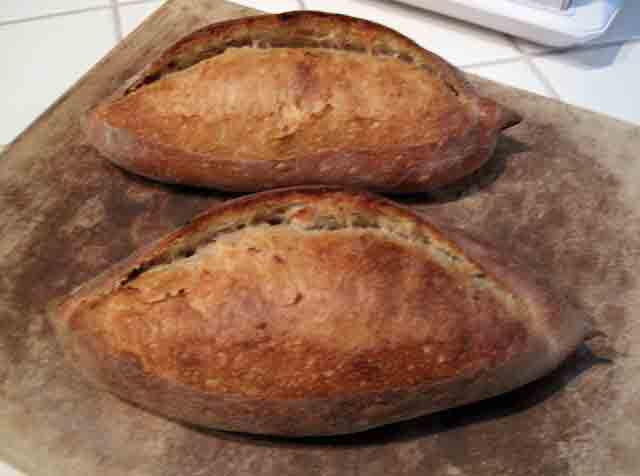
San Joaquin Sourdough. My last bake of 2012.
Happy Baking to you all in 2013!
David
- dmsnyder's Blog
- Log in or register to post comments
Seeing the dough on the couche with absolutely no flour is pretty Impressive.
Paul
That baker's linen is pretty magical stuff.
David
Your tutorials are great and this one is no exception! Loaves are beauties!
Thanks for taking the time to put this all together and post here.
Take Care,
Janet
I appreciate your kind words.
David
Very nicely done, David.
What a lovely cut of baker's linen. Great pair of San Joaquin's to sing out the old year : )
Happy New Year!
Sylvia
Happy New Year to you, too!
David
Lovely tutorial, David! very clear and informative.Those San Joakins are beauties! It sure pays off to regularly bake a favorite recipe, you have perfected it!
Happy new year,
Khalid
Happy and Healthy(!) New Year to you, too!
David
Hi David, is that 8 oz Belgian linen that you are using or something else? I'd like to source some closer to home (Canada). Thank you.
I don't know the weight or the provenance of the linen. I got it from TMB Baking. If you want to source some closer to home, find a bakery supply company or ask in a local bakery where they get theirs.
David.
This is a great tutorial David. I really appreciate the efforts in helping newer bakers like me in aspects we would otherwise have a difficult time learning on our own.
Happy New Year to you :)
John
Happy New Year to you, too!
David
Great post David.
What kind of peel are you using? Looks similar to something my wife bought me that I can't seem to get to work properly.
It's a "Super Peel" with their wide extension. If this is what you have, and you can't get it to work, contact the manufacturer. I have found him very responsive and helpful.
David
Nice to see the transfer peel in action, Nice tutorial, but as usual...well, gotta be me...
Anyway, it would be nice for you to write up the magical flipping action that actually gets the loaf on the peel - this is a source of mystery to so many and would benefit from your clear descriptions and photo taking ability. I'd do it - but just right now at this phase of my life I seem to have more than I can handle...
And I'll add my voice to praise the non stick qualities of linen. Why is is so good? The natural waxes in flax that persist throught the long process to become linen, plus the "lintless" quality of linen due to its extremely long fibers. There really are good reasons to go with the "real deal" (although microfibers are making an inroad). It seems expensive, but with care a couche will last a home baker a lifetime...
Nice stuff. Gotta go.
Pat
I really wanted to do photos or a video of the transfer peel in action, but I needed another pair of hands, and my wife was otherwise occupied. It's on my "to do list."
There are several videos on youtube.com showing flipping, but they move so fast an inexperienced baker might find them hard to process.
Happy New Year!
David
in front of a loaded couche in absolute "brain cramp" mode, but when my brain is not cramping (Like- "Why am I here? What do they expect me to do with this cloth and all this dough") - I've got a handle on it. It's those beginners that I worry about. It's a simple but essential skill if you bake baguettes or any long loaf. The ability to lift the dough from the couche and place it exactly where you want it is importantl - and from what I've found is actually easier than a lot of what people improvise.
Looking forwad to your tutorial on the transfer.
Happy New Year to you!
Pat
David, Great tutorial and beautiful loaves. I'd like to put in a plug for the couche from Breadtopia. I just got one and think it is far superior to the King Arthur one that I have been using for the last few years. Larger, sturdier, and finished nicely so it doesn't fray. -Varda
The finished seams are a nice addition, and their price is reasonable. Of course, the fraying does add a certain rustic charm to mine. ;-)
David
I went to a revolutionary war re-enactment and the folks there were buying from this small company in WI. If you need more than one and don't mind binding the edges yourself, it's a great price for good fabric.
http://www.wmboothdraper.com/store/index.php?main_page=product_info&cPath=1_7_29&products_id=969
I also use plain canvas but the linen is clearly superior as noted above.
I just sent them an email to get a quote on shipping to Canada. Seems like a decent price. Gotta worry about tall the extra costs when shipping across the border. A local artist supplies store sells 8 oz belgian linen for over $21.00 A FOOT. Slightly wider than the Booth Drapper canvas, but still way too expensive. My wife won't mind serging the ends. Thanks for the lead, PeterS.
I bought 1 meter of fine linen x 60 inches wide from a sewing supply store in Canmore, Alberta for about $15, cut it in half and folded over, so that I have 4 layers of cloth measuring roughly 18"x 30", well floured and never washed, it works just fine! For goodness sakes DO NOT pay $21 per FOOT!
Thank you for the tutorial Mr. Snyder. Great looking loaves as always. Been away for a while and it is nice to be back!
Regards, Brian
I second the motion. I have the same one and it's great.
I've used some food grade burlap from a coffee sack. Some of it is crappy but sometimes you find a sack with a nice tight weave and good weight.
and thanks to all of you top bakers; I learn so much from this website.
Believe it or not, I bought my linen at Jo-Ann Fabrics, finished the edges myself. Works great.
I love to bake whole grain seeded breads for myself, and my friends all want sourdough white bread, so I'm plugging away at both.
Happy New Year to all you bakers, may your dough rise!
Happy new year, David. I have used linen for a couple of years but you taught me something today. Are you a teacher in the real world? Thanks much and I will try to pass it forward.
Warm regards,
Marie
...you can bake a couche potato! Thanks for the lesson, Perfesser.
I used the TMB couche extensively last week. I use flour on it, because I like the look of the floured loaf.
Glenn
and you can always learn something new. I don't use my couche very often, because I have round and oval bannetons and proof my Pains a'Anciennes on perforated baguette pans. But when I used it, I always floured it heavily, I had no idea you could do without.
Happy New Year, oh Creator of the San Joaquin Sourdough,
Karin
Very helpful, David. May I feature it up front for a bit? I need to replace the holiday recipes!
-Floyd
Happy New Year!
David
i noticed your baking stone. its nice and big. where did you get it?
My stone is 14 x 16 inches. I believe I got it at Williams-Sonoma. I'm not sure they currently carry the same stone.
David
Looks like a FibraMent stone that can be purchased HERE.
David
Thanks for setting me straight and I am sorry for jumping to the conclusion I did. Looks like the one I have based on color and thickness hence my comment. Other stones I have look different and aren't as thick. Realize I should have been clear on stating my comment as purely a guess based upon your photo.
Janet
Thanks for posting that link Janet! I might order one. Been looking for one of those for some time now.
John
John,
I have a FibraMent and an Old Stone Oven stone HERE. OSO is way less expensive and I have not found any difference in performance between the 2 stones. In fact, I use the OSO regularly as it is easier to move if I need to move it around.
Janet
leaves plenty of space for heated air to move on the sides if you are going to use it with a gas oven. This is important with electric ovens, too, but more so with gas. If the stone is too large, it will inhibit the convection currents that heat the oven; it will take longer to heat up and you will have undesirable temperature gradients.
Peter,
Mine all had to be cut to size to fit into my Cadco so clearance issues can be addressed if one owns a saw which has a water supply attached :-)
Janet
And, I'll bet any local stone countertop installer/vendor would trim a baking stone gratis. They have huge saws, probably take you longer to ask than it will to cut it!
I am sure they could be tempted with a fresh loaf of bread as a bribe promise for their expertice and time :-)
That cut is impressive. I don't get how you can get such an oven rise in an electric oven. What do you think is the most important factor to get an oven rise this pronouced? Also, how did you get steam inside?
Thanks,
1. Optimal fermentation and proofing.
2. Well-shaped loaves (tight gluten sheath).
3. Oven with baking stone well pre-heated (others find this less important).
4. Steaming during the first part of the bake.
I steam the oven with a cast iron skillet filled with lava rocks. This is pre-heated in the oven on the lower rack, below the rack with the baking stone.. Just before loading the loaves, a perforated pie tin filled with ice cubes is placed on top of the lava rocks.
David
I see you have a convection oven, do you use the convection part during the steaming, or after?
Thanks,
I use the convection after the first 12-15 minutes of the bake.
David
This was a big help to me: I purchased my own large piece of linen. After cutting it to size I took the pieces to my local tailor who, for a minimal fee (actually, he didn't charge me) he used his sewing machine to run a stitch down each open side to prevent fraying. Years later, my clothes are still not coming apart.